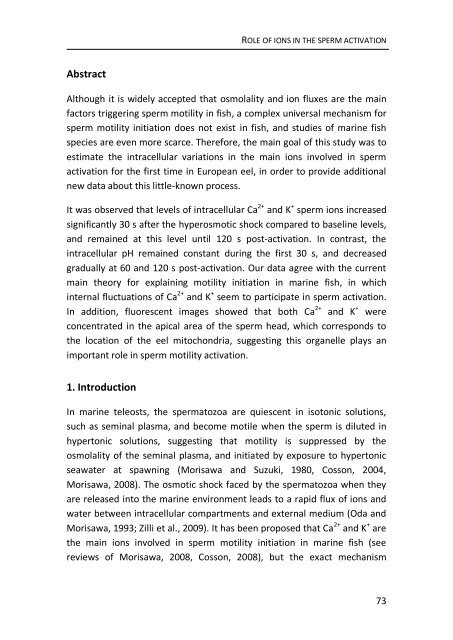chapter 3 - RiuNet
chapter 3 - RiuNet
chapter 3 - RiuNet
You also want an ePaper? Increase the reach of your titles
YUMPU automatically turns print PDFs into web optimized ePapers that Google loves.
ROLE OF IONS IN THE SPERM ACTIVATION<br />
Abstract<br />
Although it is widely accepted that osmolality and ion fluxes are the main<br />
factors triggering sperm motility in fish, a complex universal mechanism for<br />
sperm motility initiation does not exist in fish, and studies of marine fish<br />
species are even more scarce. Therefore, the main goal of this study was to<br />
estimate the intracellular variations in the main ions involved in sperm<br />
activation for the first time in European eel, in order to provide additional<br />
new data about this little-known process.<br />
It was observed that levels of intracellular Ca 2+ and K + sperm ions increased<br />
significantly 30 s after the hyperosmotic shock compared to baseline levels,<br />
and remained at this level until 120 s post-activation. In contrast, the<br />
intracellular pH remained constant during the first 30 s, and decreased<br />
gradually at 60 and 120 s post-activation. Our data agree with the current<br />
main theory for explaining motility initiation in marine fish, in which<br />
internal fluctuations of Ca 2+ and K + seem to participate in sperm activation.<br />
In addition, fluorescent images showed that both Ca 2+ and K + were<br />
concentrated in the apical area of the sperm head, which corresponds to<br />
the location of the eel mitochondria, suggesting this organelle plays an<br />
important role in sperm motility activation.<br />
1. Introduction<br />
In marine teleosts, the spermatozoa are quiescent in isotonic solutions,<br />
such as seminal plasma, and become motile when the sperm is diluted in<br />
hypertonic solutions, suggesting that motility is suppressed by the<br />
osmolality of the seminal plasma, and initiated by exposure to hypertonic<br />
seawater at spawning (Morisawa and Suzuki, 1980, Cosson, 2004,<br />
Morisawa, 2008). The osmotic shock faced by the spermatozoa when they<br />
are released into the marine environment leads to a rapid flux of ions and<br />
water between intracellular compartments and external medium (Oda and<br />
Morisawa, 1993; Zilli et al., 2009). It has been proposed that Ca 2+ and K + are<br />
the main ions involved in sperm motility initiation in marine fish (see<br />
reviews of Morisawa, 2008, Cosson, 2008), but the exact mechanism<br />
73
















